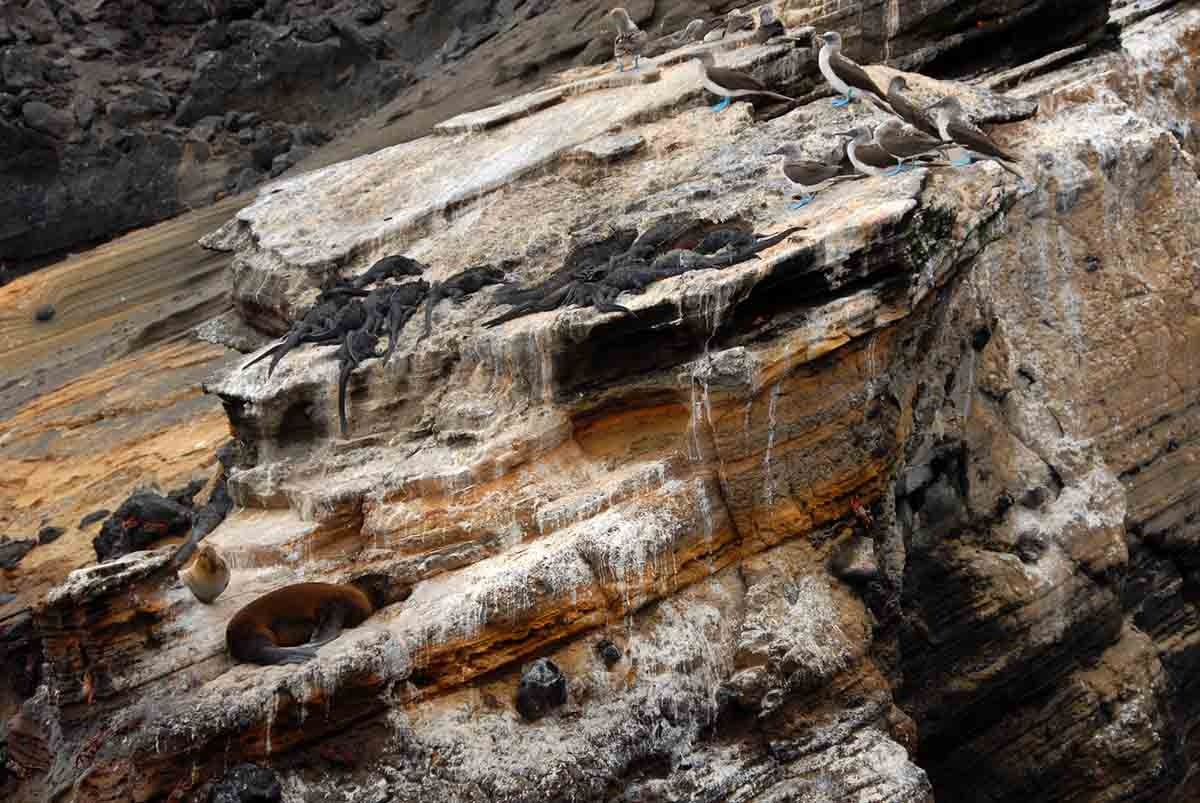Educational 5-Days Boat Trip Galapagos Experience
Bio-diversity in the Galapagos Islands has been recognized by textbooks around the world, due to its historical significance in developing Darwin's theories of evolution and natural selection.
AM: Baltra
After landing at Baltra island by air in the early morning, guests will transfer to the dock and board Santa Cruz II. After a briefing, the guests are assigned their cabins, and invited for lunch.
PM: Dragon Hill
Cerro Dragon is located on the north side of Santa Cruz. It has a fascinating terrain. This walk begins by passing a lagoon of brackish water, which is frequented by ducks, shorebirds and American flamingos. The trail continues inland and offers stunning views of the bay, western islands, and land iguanas.
AM: Vicente Roca Point
After breakfast guests can explore the coastline by dinghy while the naturalist guide explains the geology and dramatic landscape of Isabela Island. The nesting site for many Galapagos species, including flightless cormorants and Galapagos Penguins. If the weather permits, you can snorkel along the steep cliffs in this region, which is rich with marine life. Green sea turtles, oceanic sunfish (Mola Mola), and other species are often seen.
PM: Punta Espinoza
This afternoon, we will explore Fernandina - the youngest island of the archipelago. Fernandina is a unique island with an abundance of marine iguanas. Its absence of any introduced species makes it a special place. Sea lions are also found in this area, as well as Sally light foot crabs. Hawks, penguins, and flightless cormorants.
AM: Charles Darwin Station
In the morning, guests disembark (dry landing) in Puerto Ayora to visit the Charles Darwin Research Station. The Station consists of a giant tortoise Breeding Center and an impressive giant prickly-pear cactus forest that is home to many land birds. The Station also serves as the headquarters for scientific investigation, conservation and the National Park administration. Following this visit, guests will board a private transport to head up and enjoy lunch in the cooler highlands of Santa Cruz Island, which is an entirely different ecosystem.
PM: Highlands
Guests will have several options to choose from in the afternoon, these of which can be discussed in advance with your Expedition Leader. At the end of the afternoon's activities, guests will return to Puerto Ayora and hop aboard the Santa Cruz II.
AM - Baroness Overlook & Post Office Bay
A dinghy trip along the maze-like channels of Floreana’s north coast can be taken after breakfast. After breakfast, the guests can enjoy Baroness Cove and its stunning views of Floreana Island. Post Office Bay is the next stop for guests. Here, they can visit the historical barrel which has been used as a Post Office in the Archipelago since over 200 years. Guests will have the opportunity to either leave their postcards or take those left by other boats (to deliver to your addressee!) Right off the beach, snorkeling is available. After lunch, the guests return to board for a relaxing afternoon.
PM: Champions Islet & Cormorant Point
After lunch, the guests can hop on the dinghies for snorkeling or glass bottom boat and explore the underwater world around Champion Islet. This extinct shield volcanic is regarded as the best snorkeling spot in the Archipelago. Then, head to Cormorant Point. You'll start with a wet-landing on an olivine crystal beach, followed by a stroll through a lagoon of brackish water where birds like American flamingos and pintail ducks gather. Guests will then continue on their journey to the white-sand beaches where turtles nest at night (between December and May).




Included
- All programed visits as per itinerary with specialized naturalist bilingual guide
- Accommodation in twin/double Horizon Deck Explorer Cabin with private facilities, all meals on board, drinking purified water, coffee and tea
- Cruise Fuel Surcharge
- Snorkeling equipment (fins, mask & snorkel) & sea-kayaks
- Transfers within the islands on cruise dates as per itinerary
- Personalized 24/7 assistance during tour
Not Included
- Airfare to/from Galapagos from/to Mainland Ecuador (to be added)
- Galapagos National Park Entrance Fee US$100 per person (in cash only upon arrival)
- Galapagos Migration Card US$20 in cash per person (at Mainland’s Airport)
- Alcoholic/soft drinks, personal expenses, extras, tips and other services not specified in the program
- All sizes wet-suits for rent on board (in cash)
- Travel, medical & cancelation Insurance and any services on Mainland
Highlights
- Lean about Human History in the Galapagos: from pirates, English whalers and military forces to the actual Ecuadorian colonizers.
- Follow the process of Galapagos Turtles at Charles Darwin Research Center.
- Follow Darwin’s Footsteps and comprehend how he felt when rambling around amazing natural sites filled with untamed wildlife.
- Geological nature of the Galapagos Islands is fascinating and intriguing in all Islands.
- Spot Marine Iguanas, the only of its kind that scrapes for food on the seafloor.
- See how dozen of species developed peculiar features to adapt to the Islands rough environment.